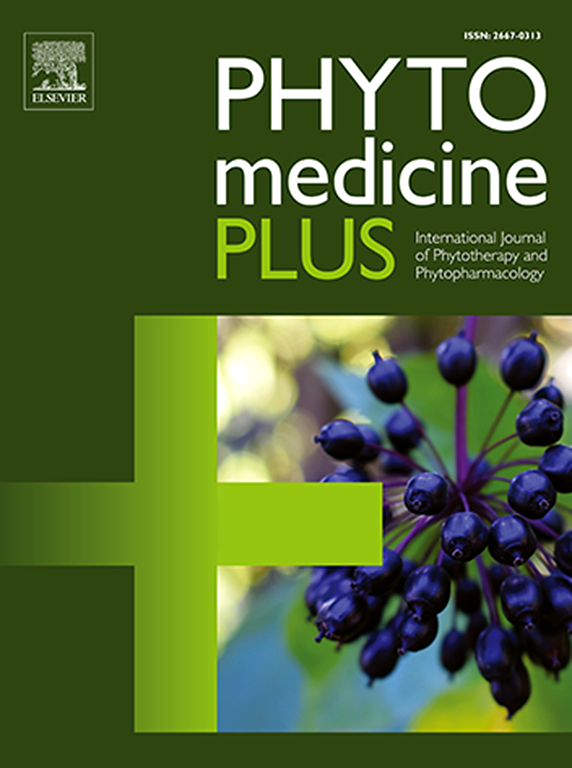从奇比纳叶中鉴定可能的抗疟成分:一种植物化学、体内和计算机方法
Q3 Pharmacology, Toxicology and Pharmaceutics
引用次数: 0
摘要
疟疾是一个重大的公共卫生问题,特别是在尼日利亚等发展中国家。由于寄生虫对大多数现有药物(包括目前的金标准青蒿素)产生耐药性,疟疾的治疗正在受到影响。中国猕猴桃。,Dalziel是Ochna staudtii Gilg的同义词,在民族医学中用于治疗疟疾、痢疾等疾病。目的采用植物化学和计算机化学的方法,从枇杷叶中鉴定可能的抗疟成分。方法采用Ryley和Peters对氯喹敏感的伯氏疟原虫(NK65)进行抑制和治疗试验,考察甲醇叶提取物及其组分(己烷、二氯甲烷、乙酸乙酯和丁醇)的抗疟作用。利用Maestro 12.8的Glide-Ligand对接面板、SwissADME和ProTox-II在线服务,在Schrödinger Suite 2021-2上进行了计算机研究。结果提取液及馏分具有显著的(p <;0.05)分别在500、250和125 mg/kg时抑制寄生;丁醇部位的化学抑制率最高,分别为94.0、98.0%和84.0%,甲醇部位的化学抑制率最低,分别为32.5、40.0%和62.0%,标准药氯喹(CQ, 5 mg/kg)的化学抑制率为94.0%。此外,丁醇组分显示显著(p <;治疗试验中,正己烷组分的治愈率分别为58.14%、74.40%和94.20%,而正己烷组分的治愈率分别为69.80%,正己烷组分的治愈率分别为41.9%、14.0%和2.3%,其活性最低。受到这些结果的鼓舞,丁醇部分使用色谱技术进行纯化,得到4 ' - o -(2E-decenyl)芦丁或4 ' - o -(2E-decenyl)槲皮素-3-芦丁苷作为主要的生物活性成分。化合物的身份是根据化学测试和核磁共振分析确定的。该化合物对pfLDH具有良好的结合亲和力(-6.822 kcal/mol)和稳定性,具有合适的药物样能力和安全性。结论枇杷叶具有明显的抗疟作用,其主要活性成分为黄酮醇二糖苷。据我们所知,这种化合物是第一次从这种植物中分离出来。本文章由计算机程序翻译,如有差异,请以英文原文为准。

Identification of possible antimalarial constituent(s) from the leaves of Ochna kibbiensis: A phytochemical, in vivo and in silico approaches
Background
Malaria is a major public health problem especially in developing countries such as Nigeria and its treatment is being compromised by resistance of the parasite to most of the available drugs, including the current gold-standard artemisinins. Ochna kibbiensis Hutch. & Dalziel, a synonym of Ochna staudtii Gilg has been employed in ethnomedicine for the treatment of malaria, dysentery, among others.
Purpose of the study
This study was aimed at identifying possible antimalarial constituents from O. kibbiensis leaves using phytochemical and in silico approach.
Methods
The antimalarial effect of the methanol leaf extract and its fractions (hexane, dichloromethane, ethylacetate, and butanol) was investigated according to the methods described by Ryley and Peters suppressive, and curative test using Chloroquine-sensitive Plasmodium berghei (NK65). In silico studies was conducted using on Schrödinger Suite 2021–2 utilizing the Glide-Ligand Docking panel of Maestro 12.8, SwissADME and ProTox-II online serves.
Results
The extract and fractions exhibited significant (p < 0.05) suppression of parasitaemia at 500, 250 and 125 mg/kg, respectively; butanol fraction was the most active with 94.0, 98.0 and 84.0 % chemo-suppression while the methanol extract was the least active with 32.5, 40.0 and 62.0 % chemo-suppression and the standard drug, chloroquine (CQ, 5 mg/kg) had 94.0 %. Also, the butanol fraction showed significant (p < 0.05) and dose-dependent effect in the curative test with 58.14, 74.40 and 94.20 % cure and CQ had 69.80 % at the tested doses while n-hexane fraction was the least active with 41.9, 14.0 and 2.3 % cure. Encouraged by these results, the butanol fraction was subjected to purification using chromatographic techniques which afforded 4′-O-(2E-decenyl) rutin or 4′-O-(2E-decenyl) quercetin-3-rutinoside as the major bioactive constituent. The identity of the compound was determined on the basis of chemical tests, and NMR analysis. The compound exhibited good binding affinity (-6.822 kcal/mol) and stability against pfLDH with appropriate and acceptable drug-like abilities and safety profile.
Conclusion
In conclusion, the leaf of O. kibbiensis have demonstrated significant antimalarial effect with a flavonol diglycoside as the major bioactive compound. To the best of our knowledge, this compound is isolated for the first time from the plant.
求助全文
通过发布文献求助,成功后即可免费获取论文全文。
去求助
来源期刊

Phytomedicine Plus
Medicine-Complementary and Alternative Medicine
CiteScore
3.70
自引率
0.00%
发文量
178
审稿时长
81 days
期刊介绍:
 求助内容:
求助内容: 应助结果提醒方式:
应助结果提醒方式:


